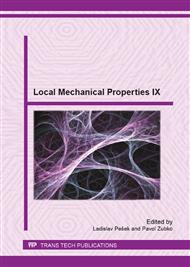p.3
p.11
p.15
p.19
p.23
p.27
p.31
p.35
Measurement of Local Initiation, Early Growth and Retardation of Physically Short Fatigue Cracks Using Amended DCPD Method
Abstract:
Different experimental methods are being used in laboratories for automatic measurement of fatigue crack growth rates and threshold values. Such data belong to mechanical properties essential for an assessment of residual life of components and structures containing cracks of length more than several millimetres. However, if the material contains small crack-like defects like inclusions or pores, knowledge about local resistance against fatigue growth of physically short cracks becomes very important. Damage mechanisms are even more complicated in case of a presence of subsurface residual stress field, e.g. due to technological effects. Experimental difficulties connected with investigation of short fatigue crack growth (FCG) can be reduced in case of use of automatic indirect methods. The aim of the work described in this paper was to explore possibilities and limits of the use of DCPD (direct current potential drop) method for physically short crack measurement and to use the optimised method for an evaluation of local damage process of initiation and early growth of short fatigue crack in residual stress field induced by shot peening.
Info:
Periodical:
Pages:
19-22
Citation:
Online since:
September 2013
Authors:
Price:
Сopyright:
© 2014 Trans Tech Publications Ltd. All Rights Reserved
Share:
Citation:


